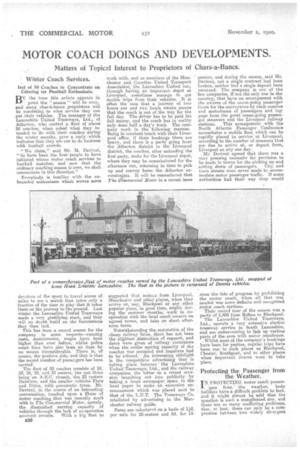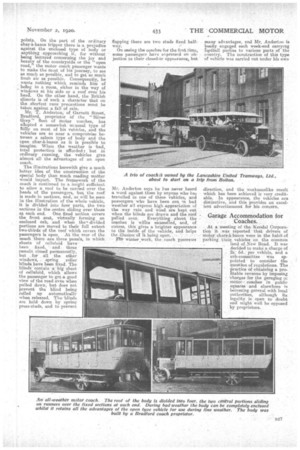MOTOR COACH DOINGS AND DEVELOPMENTS.
Page 24

Page 25

If you've noticed an error in this article please click here to report it so we can fix it.
Matters of Topical Interest to Proprietors of Chars-a-Bancs.
Winter Coach Services.
feet of 50 Coaches to Concentrate on Catering 'or POotball Enthusiasts.
RY the time this article appears in . print the." season" will be over, and .many. cha.r-it-banc,s proprietors will be wondering to what service they can put their vehicles. The manager of the Lancashire United Tramway's,' Ltd., of Atherton, who _control a fleet of about 50 coaches, when asked what they intended to 'do with their -coaches during the winter months, gave a reply .which indicates -that they are out to do business
with football crowds. • . "W claim," said Mr. IL Devinni, " tie have been the firet'people to have initiated winter motor coach services to football matches, and now that the ordinary coaching season is over, we shall concentrate in this direction."
Everybody ia familiar with the unbounded enthusiasm which moves some devotees of the sport to travel scores of miles to see a match that takes only a fraction of the time to play that it takes them on the journey to the ground. Last winter the Lancashire United Tramways made a very gratifying start, and they will no doubt build on the foundations they then laid.
This has been a record season for the. Company: in some respects—running costs, maintenance, wages have been higher than ever before whilst police court fines have also been an item by no means inconsiderable: There is; of course, the positive side; arid that is that the record number of passengers has been carried: The fleet el 50 coaches consists of 14, 23, 28t29, and 33 seaters, the last three being on A.E,C: chassis, the 23 seaters Daimlers, and the smaller vehicles Fiats and Miles, with :pneumatic Ayres. Mr. Devinni, in the course ofan interesting conversation, touched upon "Shase of motor coaching_ that was recently dealt with in The Coyhdnereia2 Motor, namely, the diminished earning capacity of vehicles through the lack of co-operation amongst owners. With a big fleet to
B26 work with, and as members of the Manchester and. Counties United Transport A.ssociatiOn, the Lancashire United can, .
through having an important depot at
Liverpool, sometimes manage to get double 'trips from their vehicles. It is often the case that a .journey of two hours out and two hours return _means that the coach is out of.the way for the full day. The-driver has to be paid his foll money, and the coach has in reality only dale half aday's *ark. The corn
• pany work in the 'following manner. Being in constant touch Witlftheir Liverpeel office; if their bookings there are heavy, and there is a party going front the Atherton district to the Liverpool district, the coaches, after unloading the first party, make for the Liverpool depot, where they may be commissioned for the afternoon run, returning in time to pick up and convey home the Atherton exenrsicarists. It will he remembered that 7'h4 atonviercia/ Motor in a recent issue suggested that mote:as: from Liverpool, Manchester and other places, when they . arrive 'at, 'Bay; Blackpool or any . other popular place, in good time, might; during the summer' Months,.work in co' operation With the local coach owners on agreed terms, and take on short afternoon tours.
Notwithstanding the restoration, of the cheap railway fates, there has rot been the elightest .diminution of support,. and dates were given of railway'. excursions when the entire-seating capacity of the coaches was Occupied and, inquirers had to be refused.' An interesting sidelight is the competitive. advertising that is taking place between' the Lancashire United.Tramways, Ltd.', and the -railway .. companies; the latter on a recent occasion launching out into publicityby taking .a large newspaper space in the local: paper to make an excursion ,an.• nouneement which was placed next to that a the L.U.T. The Tramways Co. retaliated by . advertising in the Manchester railway guide.
Fares are calculated on a basis of 10. per mile for 28-seaters and 2d. for 14
seaters, and during the season, said Mr. Devinni, not a single contract had been broken, neither had a single deposit been returned. The company is one of the • few companies, if not the only one in the country, that have an arrangement with the owners of the ocean-going passenger liners for the conveyance by their coaches and motorbuses of Passengers and luggage from the great ocean-going passenger steamers and the Liverpool railway stations. This arrangement with the North Atlantic Passenger Conference necessitates a mobile fleet which can be rapidly placed in service' at Liverpool, according to the number of steamers that are due to arrive at, or depart from, Liverpool on any one day.. _Mr. Devinni agreed that there was a very pressing necessity for provision to be made in towns for the picking up and setting down of passengers. City and town streets were never made to accommodate motor passenger traffic. If some authorities had their way they would stem the tide of progress by prohibiting the motor couch, when all that was needed was some definite and recognized Motor_ coach stations.
Their record tour of the season was a party of -1,400 from Bolton to Blackpool.
The Lancashire United Tramways, Ltd., operate a very extensive electric tramway service in South Lancashire, and are endeavouring to link up various parts of. the area with motor omnibuses.
Whilst most of the oompany's bookings have been for parties, regular trips have been, rim to -such places as Blackpool, • Chester; Sontbport2and to other places when important events were to take place.
• Protecting the Passenger from • • . • the Weather. pi..PRQTECTING motor coach passengers from the weather, body builders. ha,Ve a difficult problem to face, and it might almost be said that the question is such a complicated one, and there are so many conflicting problems, that, at best, there can only be a corn.promise between two widely divergent points. On the part of the ordinary ehar-h-bancs tripper there is a prejudice against the enclosed type of body or anything approaching it, for without being lectured concerning the joy and beauty of the countryside or the "open road," the motor coach passenger wants to make the most of his journey, to see as much as possible, and to get as much fresh air as possible. Consequently, he wants nothing which reminds him of being in a room, either in the way of windows at his side or a roof over his head. On the other hand, the British climate is of such a character that on the .shortest runs precautions must be taken against a fall of rain. Mr. T. Anderton, of Garnett Street, Bradford, proprietor Of the "Silver Grey_" fleet of motor coaches, has adopted a somewhat unusual type of Bo—dy on most of his vehicles, and the vehicles are as near a. compromise between a saloon type of body and the open char-asbancs as it is possible to imagine. When the weather is bad, total protection is afforded: but in ordinary running, the vehicles give almost all the advantages of an open coach.
The illustrations herewith give a much better idea of the construction of the special body than much reading matter would impart. The framework of the coach is continued to a height sufficient to allow a roof to be carried over the heads of the passengers, but the roof is made in sections, and, as will be seen in the illustration of the whole vehicle, it is divided into four parts, the two sections in the centre sliding over those at each end. One fixed section covers the front seat, virtually forming an enclosed cab, and when the" divided. portions are moved to their full extent two-thirds of the roof which covers the passengers is open, At the rear of the coach there are three panels, in which sheets of celluloid have •
been fixed, • and these remain closed permanently, but for all the other windows, spring roller blinds have been fixed. The blinds contain a: big sheet of celluloid, which allows the passenger to get a good view of the road oven when pulled down, but does not prevent the blind being rolled up automatically when released. The blinds are held down by spring press-studs, and to prevent
flapping there are two studs fixed halfway. On seeing the coaches for the first time, some passengers have espressed an objection to their closed-in appearance, but
Mr. Anderton says he bas never heard a word against them by anyone who has travelled in one of these vehicles, and passengers who have been out in bad weather all express high appreciation of the way rain and wind, are kept. out when the blinds are drawn and the roof pulled over. Everything about the coaches is white enamelled, and, of course, this gives a brighter appearance to the inside Of the vehicle, and helps the illusiona it being open. .• •
.Fin• winter work, the coach possesses many advantages, and Mr. Anderton is busily engaged each week-end carrying isvtball parties to various parts of the country. Tile construction of this type of vehicle was carried out under his own
direction, and the workmanlike result which has been achieved .isvery creditable. able. In appearance, the vehicles are distinctive, and this provides an excellent advertisement for his concern.
Garage Accommodation for Coaches.
At a meeting of the Kendal Corporation it was reported that drivers of Motor chars-kbancs were in the habit of parking their, vehicles on the common
land of,NeWr Road. It was • decided to make a charge of
• 2s: 6d.; per _vehicle, and a sub-committee was
pointed to to consider the question of regulations. The practice of-obtaining a profitable revenue by imposing 'charges for the garaging at motor • coaches in public squares and elsewhere ia becoming general with local authorities, although its legality is open to doubt and might well be opposed by proprietors.


























































